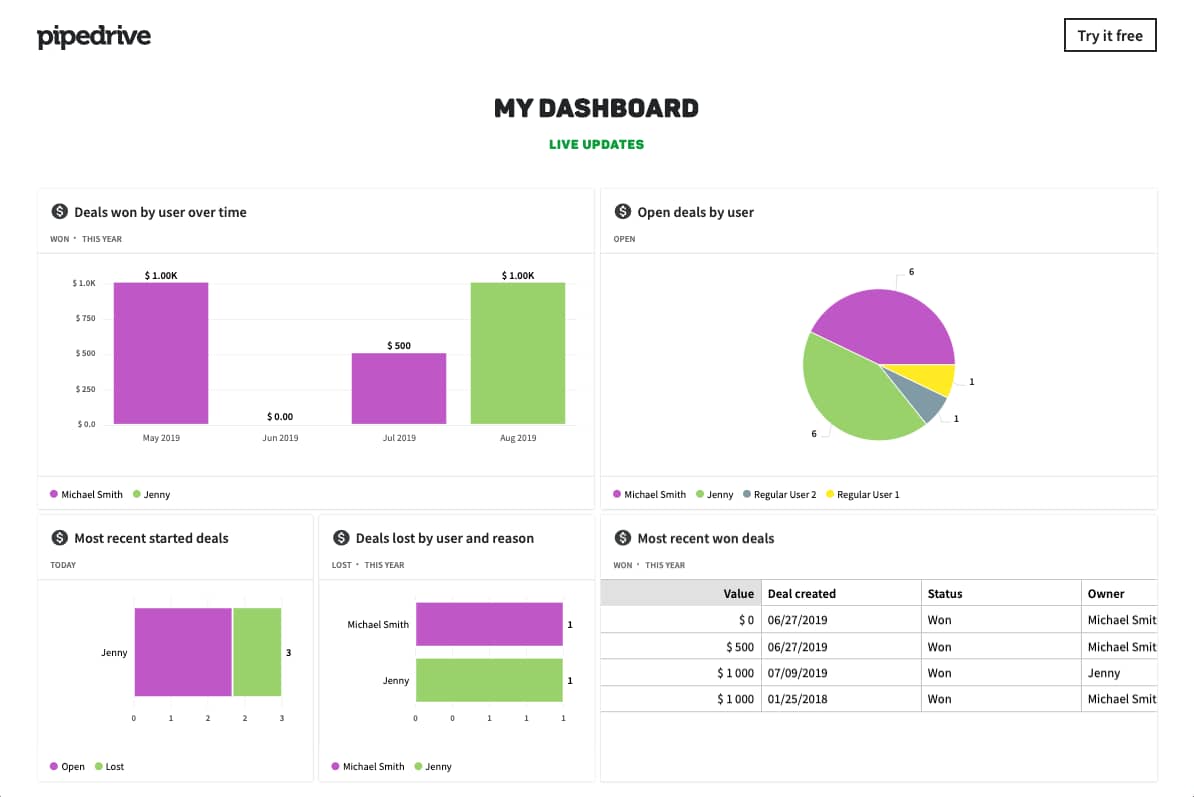If you want to run an effective sales team, you need to own your data and have a rigorously tested sales reporting strategy.
Most sales aren’t closed in a single meeting – they require consistent tracking and follow-up.
This guide highlights how to use sales report templates to uncover valuable insights for nurturing leads and closing more deals. We’ll also outline nine sales report examples with templates to help you review, evaluate and forecast team goals.
Why sales reports are so important to your business
You and your team juggle a variety of day-to-day sales activities. To keep everything running smoothly, you need to report and discuss data with your reps regularly.
Here are some big-picture benefits of a consistent, in-depth sales reporting process.
Reports help align the goals of your sales team and company at large
Departments that prioritize cross-collaboration and communication are more likely to see positive results. LinkedIn found that 85% of sales and marketing leaders believe the aligning the two departments is their most significant opportunity for improving business performance.
Goal-setting around sales targets and quotas is rooted in your data. Until your sales reps know what those goals and benchmarks are, they’re in the dark.
Get organized with your free sales pipeline excel template
More transparency and accountability among your reps
Sales managers must have a pulse on who their top performers are. The same is true for salespersons who might be struggling. If you don’t know who’s driving your team forward, or holding it back, you won’t be able to replicate productive behavior or make necessary improvements.
Your reps need to know where they stand. Gallup research notes that employee engagement is directly related to how well managers develop their workers.
A good sales management process helps you coordinate your sales operations, motivate your team and ultimately boost your sales team’s performance. Through weekly sales activity reports and check-ins, reps can reflect on their sales strategies so that, rather than losing motivation, they’re empowered to improve over time.
Encourage a culture of teamwork and collaboration
Although sales representatives are often fueled by competition, teams are ultimately working toward the same goal: to win deals.
Sharing data across your team helps create a much-needed sense of motivation for your reps to come together and hit their quotas.
More accurate sales forecasts and goal-setting
In a day and age where 60% of sales reps meet their sales targets, any given team can benefit from better sales forecasting.
Real-world data means more accurate projections regarding sales revenue goals, which influences everything from your sales strategy to hiring reps and beyond.
Additionally, sales analysis reports highlighting performance and successful activities can help you prioritize actions resulting in closed deals. In turn, you can set more accurate and attainable sales goals.
Sales pipeline and reporting templates to get you organized
Benefits of sales reporting to drive short-term action and long-term strategy
Effective sales reporting goes beyond just number of sales. It’s a powerful tool that fuels immediate course corrections and long-term strategic planning. Let’s explore how different sales reports contribute to this process:
Daily sales reports: spotlight on activity
Daily reports provide a real-time snapshot of your team’s sales activities. They track metrics like the number of calls made, emails sent, meetings booked and presentations delivered.
By monitoring these activity levels, you can identify potential issues early on. For instance, a sudden drop in calls made could indicate a scheduling conflict or a need for additional sales training. This allows you to take swift action to ensure your team stays on track.
Weekly sales reports: identify trends and make adjustments
Weekly custom reports allow you to see patterns emerge over a slightly longer timeframe. They can reveal trends like fluctuations in conversion rates, changes in average deal size or shifts in lead quality.
With this data, you can investigate and address any concerning trends before they significantly impact your sales pipeline.
For example, a dip in conversion rates might prompt you to revisit your sales pitch or refine your qualification process for leads. Weekly reports empower you to make these adjustments quickly and effectively.
Monthly sales reports: big picture analysis and better decisions
Monthly reports offer a broader perspective, revealing seasonal trends, pipeline health over time and the overall effectiveness of your sales strategies.
Here, you’ll want to monitor key metrics like sales growth (month-over-month, year-over-year), win rates and customer acquisition cost (CAC). This comprehensive data empowers you to make informed strategic decisions.
You can identify areas for improvement, adjust sales targets based on realistic forecasting and allocate resources more effectively.
9 sales report examples your team can actually use
There are many different types of sales reports. You’ll likely need more than one sales report format to give yourself a comprehensive view of your company’s strategy.
Combining the following sales report samples and salesperson report templates can help you better forecast your team’s performance.
1. Sales pipeline report
A sales pipeline template covers the status and progress of your team’s deals, all broken down per quarter. This spreadsheet is a straightforward way to predict and forecast your deals in Microsoft Excel or Google Sheets if you don’t yet have a dedicated reporting tool or CRM.
Rather than dig into the specific details of your sales cycle and individual team performance, this effective sales report template is more concerned with the big picture – making it an ideal resource to share with stakeholders outside of your sales team.
However, as your team grows, you’ll need to migrate to a dedicated CRM that opens up opportunities for teamwide collaboration and allows you to dig deeper into individual actions. A CRM’s task automation features should also eliminate some time-consuming admin work.
2. Weekly sales report
Here is a weekly sales report created using the template you can receive from the CTA at the top of this article.

Weekly sales reporting allows you to uncover trends among your sales team without micromanaging your reps. Additionally, your data here can represent talking points during your weekly sales meetings or stand-ups.
A weekly sales report template primarily examines individual sales reps’ performance and actions. For example, who wins the most sales leads? Who conducts the most outbound calls?
You can also use weekly sales reports to keep an eye on total meetings and conversions to ensure that your team is operating at peak productivity.
3. Monthly/quarterly sales report
Here you’re focused on big-picture trends, the overall health of your funnel and revenue.
The upside of a monthly sales report template is that you’ve given your sales team enough time to gather actionable data. If you want to determine what’s working and what’s not, a month or two is typically more than enough time.
For example, a consistent drop in conversions or calls made month-to-month is a cause for alarm, while an uptick in sales or conversions shows you that you’re doing something right. Accurate reporting will help you determine what and how to keep doing it.
This is also a key status report to share beyond your team. It provides a general overview of how your sales department is doing in your company's context.
4. Individual (or team) progress report
Putting together a sales report template for each rep allows reps to own their data and instills a sense of accountability.
Individual reporting gives you a clear view of your top-performing reps and what they’re doing well.
Below is an example of a smaller team report (broken down by individual performance) in Pipedrive. Our platform allows you to control permissions and access when it comes to sharing. In other words, you can limit individual access to certain reports so you don’t have to worry about reps looking over each other’s shoulders.

5. Lead status target report
In some cases, you might need a sales report template dedicated to a single lead or account.
Monitoring your lead status means keeping tabs on each interaction that moves them closer to becoming a customer. Such a report gives you an actionable to-do list of next steps for nurturing your most valuable leads.
6. Annual sales plan report
It’s tough to predict the future (especially in today’s climate). Reports of prior sales plans can help you create a useful action plan for the coming year.
Your annual sales plan builds off last year’s reporting to help you determine your sales targets, campaigns and how many reps you need to pull it all off.
7. Sales and marketing report
Aligning sales and marketing is crucial to your business’s success. Reporting on the performance of both operations in the same sales report template helps you monitor how well they’re working together.
The ability to track your most valuable marketing channels and actions goes hand in hand with delivering a better ROI for both departments' efforts. This is true for various efforts, including leads from Google, paid ads, cold emails, sales call reports, blog posts, social media and everything in between.
Your company’s sales department should make an effort to collaborate with marketing when it comes to both strategy and reporting. Not only does this streamline your sales process, it also allows you to gather valuable data regarding how your email leads perform versus leads from other sources.
8. Daily sales report template
Here is an example of a daily sales report template created using the spreadsheet you can receive from the CTA at the top of this article.

Daily sales activity reports should be short and sweet. Rather than worrying about trends, these reports are focused on the facts of a given day.
For example, how many meetings did you book yesterday? Who managed to close a deal? Tracking daily sales activities is important for keeping track of both individual and team-wide success in the short term.
9. Activities report
Activities reports allow you to take an in-depth look at your team’s productivity and identify which activities are helping you drive more sales.
With accurate activities reports (such as what you get from Pipedrive’s activities performance insights), you can see who in your team completed the most activities and get an overview of planned activities, and then track how much of the planned work is completed.
What are some important KPIs for sales reporting?
There are plenty of sales metrics to help measure success. You can’t possibly fit them all in a single sales report template (nor should you try).
Here’s a rundown of important sales KPIs to watch throughout your reporting to ensure you can translate the right data into action.
Emails sent and/or calls made
The importance of tracking emails and calls is twofold. Not only are you trying to determine how productive your reps are, but also how many of these activities result in demos and bookings.
Track crucial activities like calls made, emails sent, meetings set up and deals closed. This data reveals team productivity and helps pinpoint areas needing improvement.
Completed activities per user
Based on completed sales activities, you can determine which actions are most valuable and which reps are crushing their quotas.
New deals added
For the sake of your reps and sales growth, you should ideally be adding new deals consistently. If you’re not consistently increasing your number of deals, you should re-strategize how to drive more leads into your pipeline.
The number of leads in the pipeline includes the total number of leads at all stages (initial conversations, pitches, proposals, closed deals). Track the number at each stage and how long they’ve been there to identify potential bottlenecks. Monitor how many new leads enter your pipeline over time.
New deal value
More deals don’t necessarily mean better deals. Monitoring value puts your deals into context and determines which of them you should prioritize.
Assigning an estimated value to each lead, even if approximate, helps you build accurate revenue forecasts and make informed business decisions.
Deals won
What does it take to get someone through your sales funnel to eventually convert? Finding common threads between closed deals can help refine your sales department’s strategy over time.
Your close rate shows how many leads you close for every open lead, providing a quick measure of your sales strategy’s effectiveness.
Deals lost
You should note your losses just as you want to celebrate your wins. If deals are dropping off at the same stage in your funnel, that’s not something you can ignore. This is where resources like Pipedrive’s “Lost reasons” report are invaluable.
Lead conversion rate
Conversion rates are crucial for evaluating the efficiency of your sales strategy and determining whether your sales revenue targets are realistic.
Average conversion time
Understanding the average time it takes for someone to convert can help you set more realistic goals for sales performance.
A sales cycle measures how long it takes a lead to travel through the sales pipeline. A shorter sales cycle indicates an efficient sales process.
Sales by source
Knowing where your buyers are actually coming from allows you to prioritize the appropriate sales channels and build more targeted marketing campaigns.
Customer lifetime value (LTV)
Customer lifetime value (LTV) predicts how much a customer is worth to your business throughout your relationship.
Given how much it takes to acquire versus retain a customer, improving your LTV and generating recurring revenue should be a top priority. Additionally, LTV is a key metric for sales forecasting.
Churn
Churn or churn rate is a measure of how many customers stop doing business with you over a specific time period. Both quantitative and qualitative, your churn rate directly influences your sales forecasts and further clues you in on why your customers ultimately bounce.
How to make your sales reports effective
You know how to write a sales report. What next?
Here are some tips to ensure that your salespeople treat your data as more than just numbers on a spreadsheet.
Share your sales performance reports with your team
Performance data isn’t something that sales managers should keep to themselves. For the sake of improving your strategy and keeping your colleagues engaged you’ve got to share the wealth.
All of the sales templates above are prime for sharing. There is no “right” way to share your data, but here are some quick ideas that go beyond face-to-face meetings:
Reviewing via screen-sharing platforms (such as Zoom)
Featuring reporting data on your Kanban board (e.g., Trello, Asana)
Scheduling weekly or monthly emails that highlight your key sales reports
Anything you can do to make your reporting more accessible and share-worthy is a plus. For instance, present data in easy-to-read visuals like graphs and pie charts.
Give your reps a pulse on what’s happening and how they can improve. Reports are a time-efficient way to provide those answers at a glance.
Don’t drown your team in data
Reporting can almost be addictive. The more you dive into your data, the deeper you want to go in terms of details and specifics.
However, stick to the facts when sharing total sales volumes with your team. Otherwise, you risk overwhelming them. This means you’re responsible for determining which KPIs you share and also how often you decide to send reports.
There is no one-size-fits-all approach to reporting in terms of frequency. Small business teams might discuss sales data during their daily stand-up while larger teams might review reports in greater detail at the end of the week. As long as you’re reflecting on your data, you’re on the right track.
Translate your data into actionable steps
The end goal should be action on behalf of your team. Maybe that means rethinking your call volume or investing more in a certain channel.
Either way, you’ll never know what to do next until you talk about your data. That means establishing clearly defined next steps and priorities based on your knowledge.
Beyond simply sharing a templated sales report, your team is responsible for answering the following:
Are we on track to reach our sales goals?
If not, what changes do we need to make? If so, what are we doing well?
How can we have better conversations with our customers?
With these questions in mind, you can point toward action items to guide your sales strategy moving forward.
Tools to create the best sales reports
As a company grows, working from spreadsheets gets complicated quickly. Creating insightful, timely sales reports is infinitely easier with purpose-built tools. This is where a good CRM comes into its own.
You’ll want a CRM that combines detailed sales reporting with a user-friendly interface. One that empowers your team to feel in control of their targets, while giving you the tools to manage your sales pipeline and not forcing you to follow its own sales management logic.
Use it wisely and they’ll not only help you tweak your sales process to perfection. A CRM will help you guide your business forward.
Why not check out our global sales performance review for a global insight into how others sell.
Final thoughts
Reporting is an absolute must for teams today. With the help of our templates for sales reports, you can start organizing your data ASAP.
Hopefully, these examples, KPIs (Key Performance Indicators) and tips will put you and your team on the path to owning your data. Start by downloading Pipedrive’s free sales report template today.











